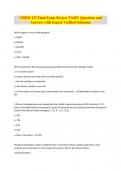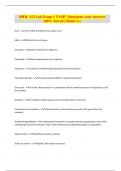-
1. Exam (elaborations) - Engineering 102 exams 1 & 2 tamu ijaz questions with complete solutions |100% pass
-
2. Exam (elaborations) - Tamu engr 102 (python coding) questions with complete solutions |100% pass
-
3. Exam (elaborations) - Engineering 102 tamu final exam study guide questions and answers with complete solut...
-
4. Exam (elaborations) - Engineering 102 tamu final exam questions and answers with complete solutions |100% p...
-
5. Exam (elaborations) - Tamu campusologies questions (all campusologies, articles and cadet oath for 2015-202...
-
6. Exam (elaborations) - Tamu campusologies questions with expert solutions |updated & verified
-
7. Exam (elaborations) - Tamu campusology guide questions with expert solutions |updated & verified
-
8. Exam (elaborations) - Ansc 107 exam 2 tamu exam prep questions with expert solutions |updated & verified
-
9. Exam (elaborations) - Ansc 107 exam 2 tamu study guide questions with expert solutions |updated & verified
-
10. Exam (elaborations) - Ansc 107 exam 2 tamu questions with expert solutions |updated & verified
-
11. Exam (elaborations) - Microbiology tamu exam 1 questions with expert solutions |updated & verified
-
12. Exam (elaborations) - Ento 320 tamu exam 1 study guide questions with expert solutions |updated & verified
-
13. Exam (elaborations) - Phil 482 tamu exam 1 questions with expert solutions |updated & verified
-
14. Exam (elaborations) - Pols 206 tamu exam 1 questions with expert solutions |updated & verified
-
15. Exam (elaborations) - Pols 206 tamu practice exam 1 questions with expert solutions |updated & verified
-
16. Exam (elaborations) - History 105 tamu exam 2 questions with expert solutions |updated & verified
-
17. Exam (elaborations) - Hist 105 mcglone tamu exam 2 questions and answers with expert verified solutions
-
18. Exam (elaborations) - Tamu hist 105 exam 2 mcglones questions and answers with expert verified solutions
-
19. Exam (elaborations) - Tamu history 105 resch exam 1 questions and answers with expert verified solutions
-
20. Exam (elaborations) - Tamu history 105 resch exam 2 questions and answers with expert verified solutions
-
21. Exam (elaborations) - History 105 exam 1: tamu lenihan questions and answers with expert verified solutions
-
22. Exam (elaborations) - Tamu history 105 resch exam 1 questions with expert solutions |updated & verified
-
23. Exam (elaborations) - Tamu resch hist 105 final test questions with expert solutions |updated & verified
-
24. Exam (elaborations) - Chem 237 final exam tamu everything (this ql includes every assignment from this clas...
-
25. Exam (elaborations) - Chem 237 final exam review tamu questions and answers with expert verified solutions
-
26. Exam (elaborations) - Tamu biol 320 test 1 questions and answers with expert verified solutions
-
27. Exam (elaborations) - Ansc 107 exam 1 tamu questions and answers with expert verified solutions
-
28. Exam (elaborations) - Chem 237 - organic chemistry lab final exam tamu 100% solved
-
29. Exam (elaborations) - Tamu acct 229 exam 1questions and answers 100% solved
-
30. Exam (elaborations) - Tamu comm 315 - exam 1 questions and answers 100% solved
-
31. Exam (elaborations) - Bio 111 lab tamu exam 1 questions and answers 100% solved
-
32. Exam (elaborations) - Tamu geography 305 test 1 questions and answers 100% solved | latest 2024
-
33. Exam (elaborations) - Anthropology exam 1 tamu lynch questions and answers 100% solved | 100% pass
-
34. Exam (elaborations) - Tamu chem 238 final exam questions and answers 100% solved | already passed
-
35. Exam (elaborations) - Biol 111 final tamu – fletcher questions and answers 100% solved | already passed
-
36. Exam (elaborations) - Bio 111 tamu fletcher exam 3 questions and answers 100% solved | graded a+
-
37. Exam (elaborations) - Bio 111 lab final exam tamu questions and answers 100% solved | graded a+
-
38. Exam (elaborations) - Biol 112 lab exam 1 tamu questions and answers 100% solved | rated a+
-
39. Exam (elaborations) - Tamu bio 111 exam 1 study guide (ch 1-5) questions and answers 100% solved | rated a+
-
40. Exam (elaborations) - Tamu bio 111 lab exam 2 review 2024/2025 questions and answers 100% solved | 100% pas...
-
41. Exam (elaborations) - Tamu bio 111 exam 1 2024/2025 questions and answers 100% solved | 100% pass
-
42. Exam (elaborations) - Biology 111 exam 1- tamu questions and answers 100% solved | 100% pass
-
43. Exam (elaborations) - Tamu biol 111 fletcher final test questions and answers 100% solved | already passed
-
44. Exam (elaborations) - Bio lab exam 2 tamu questions and answers 100% solved | already passed
-
45. Exam (elaborations) - Tamu bio 107 exam 2 - christopher lee questions and answers 100% solved | already pas...
-
46. Exam (elaborations) - Tamu chem 238 final exam questions and answers 100% solved | already passed
-
Show more






